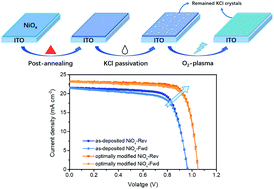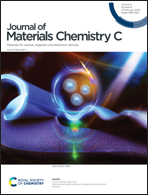Interface modification of sputtered NiOx as the hole-transporting layer for efficient inverted planar perovskite solar cells†
Abstract
Nickel oxide (NiOx) as a hole-transporting layer (HTL) in perovskite solar cells (PSCs) has been studied extensively in recent years. However, unlike the solution-processed NiOx films, magnetron sputtered NiOx exhibits relatively low conductivity and imperfect band alignment with perovskites, severely limiting the device performance of PSCs. In this study, a synergistically combined strategy consisting of triple interface treatments – including post-annealing, O2-plasma, and potassium chloride treatments – is employed to modulate the optoelectronic properties of the sputtered NiOx films. Through this approach, we successfully obtained NiOx films with increased carrier density and conductivity, better energy level alignment with the perovskite absorber layer, reduced interface trap density, and improved interfacial charge extraction. PSCs using this modified sputtered NiOx as the HTL deliver a highest stabilized efficiency of 18.7%. Our result offers an alternative method to manipulate sputtered NiOx thin film properties and thereby sheds light on a manufacturing pathway to perovskite solar cells featuring sputtered NiOx HTL.

- This article is part of the themed collection: Journal of Materials Chemistry C Lunar New Year collection 2021


 Please wait while we load your content...
Please wait while we load your content...